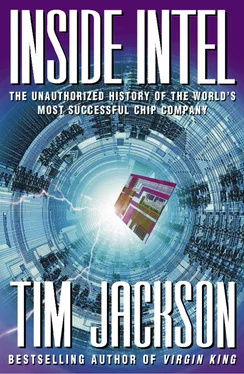2
2,000 Starts a Week
GREAT CHANGES WERE HAPPENING in the world during the long, hot summer of 1968. In Paris, students set up barricades against their college professors and the government. In Chicago, demonstrations against the war in Vietnam turned into riots that marred the Democratic National Convention. But the foundation of Intel, which has had a bigger effect on the lives of people in the world than either of these, took place without being noticed outside the narrow confines of the Bay Area’s electronics industry.
That was just how Gordon Moore liked it. The very opposite of a self-publicist, he instinctively avoided talking about his achievements until they were complete.
When Moore was asked by one of the local papers at the beginning of August what kind of devices he and Robert Noyce intended to build at their new company, his response was about as uninformative as it could be: ‘We particularly are interested in the product areas that none of the manufacturers are supplying,’ he said.
Come on, Gordon, that’s hardly news. You wouldn’t be setting up a new company just to copy something already on the market, would you?
When asked to elaborate, Moore would offer only two further thoughts. First, the new company would avoid direct government business. Second, the company would keep to the industrial end of the business rather than trying to develop products for end consumers.
From anyone else, this apparent vagueness might have indicated indecisiveness. But Moore hadn’t spent nine years at the helm of Fairchild’s extensive R&D operation for nothing. His principle was straightforward: there was no need to give away any information, however trivial, to potential competitors. If the people who had backed him and Noyce to the tune of several hundred thousand dollars each could do without detailed information on their technical plans, then so could the rest of the world.
This was no surprise to those who had known him at Fairchild. Moore was always hard to pin down on technical detail, even when he was giving a speech in public. When he was once sitting on a panel at a technical conference devoted to semiconductor materials, someone in the audience raised a question about the silicon nitride layers that Moore’s technical team were rumoured to have been experimenting with. What had the results been?
‘We got exactly the effect we were predicting,’ he answered. There was just one piece of crucial information he withheld from the audience. The engineering team had come to the conclusion that silicon nitride deposits would have no useful technical effect, and some careful tests had proved them right. But Moore thought that if it had taken his own researchers weeks to discover that the technology was a dead end, there was no reason to tell the world. Let the competition waste some time, too.
Behind the veil of vagueness, however, Noyce and Moore knew exactly what business they were going to go into. They would build memory devices. Across America, companies were buying mainframe computers to manage their accounting systems or payroll or medical records. In every case the computer needed a place where programs and data from work in progress could be stored, and then retrieved at high speed. Yet while integrated circuits were increasingly being used in the logic devices that carried out the calculations themselves, memory storage was struck in the pre-transistor age. The cheapest form of computer memory was ‘magnetic core’, a tiny magnetic doughnut which stored information in the form of ones and zeros depending on the way it was magnetized. If only a way could be found to integrate memory cells on to the circuits that Noyce had pioneered, then computer memory could become far more compact and speedier to operate. Once one computer company began to use integrated-circuit memory, the rest would follow suit. Then a virtuous circle of increasing volumes and falling costs would follow, ending up with the complete replacement of core memory with the new semiconductor devices. The potential market was millions upon millions of units a year.
A good reason for keeping so quiet about Intel’s plans was that Moore and Noyce were not alone in seeing this potential. The idea that core memory was eventually going to be replaced by semiconductors wasn’t a wild-eyed obsession held only by eccentrics. It was the received wisdom inside the industry. Route 101, the highway that ran south from San Francisco through the Valley and then onwards to Los Angeles, was dotted with laboratories racing to be the first to develop semiconductor memory devices.
Gordon Moore, though, had a head start. Shortly before his departure from Fairchild, a gifted young Italian semiconductor scientist in his department named Federico Faggin, had invented a new variation on the standards integrated-circuit manufacturing process, known as metal oxide on silicon. By 1968 the new technique, called ‘silicon gate’, was working stably in the laboratory, but it was still far from being a commercial product. With $2m in the bank, and a team of good engineers behind them, Moore knew that he and Noyce could make as good a stab as anyone else in the world at taking this technology and developing it to the point where memory devices could be mass produced at low cost.
But silicon-gate MOS was only one of three promising approaches to the problem of building integrated memory circuits. Another was to build multichip memory modules; a third was to use a process known as Schottky bipolar. Moore and Noyce decided that they would pursue all three simultaneously – and sell whichever they were able to mass-produce first. (Since Schottky proved easily replicable by competitors and multichip modules too hard even for Intel, Moore came to refer to the decision to pursue three lines of research simultaneously as the ‘Goldilocks’ strategy. Like the bowls of porridge left by the bears, only silicon gate turned out just right.)
The scientists left behind at Fairchild after the departure of Noyce and Moore would later respond with hurt pride to the news that their former boss and his new company were trying to commercialize an invention made in their laboratory. They put up a large placard, visible to all comers to the R&D department, emblazoned with the words SILICON GATE WAS INVENTED HERE. One former employee of both companies, looking back, put the accusation baldly: ‘Intel was founded to steal the silicon gate process from Fairchild’. Another was more forgiving: ‘What [we] brought with us was the knowledge that [we] had been some built, and the knowledge of the device physics … We didn’t bring with us recipes, mask sets, device designs, that sort of stuff … What we brought was a lot of knowledge’.
In any case, Fairchild Semiconductor had only itself to blame for the loss of one of its key secrets to a new competitor. For a couple of years now, the best technologies developed in its research labs in Palo Alto had not been making it to Fairchild’s Mountain View manufacturing facility. Instead, they seemed to be attracted by some osmotic principle to Charlie Sporck’s manufacturing aces at National Semiconductor.
This was partly because the rules were different in the 1960s. The days had not yet arrived when technology companies would use patents, trade secrets and other forms of intellectual property as commercial weapons. Scientists were happy to assign to their employer the rights in any patents they earned, in return for a token dollar and a framed copy of the first page of the patent. Why should they be any less generous when it came to scientists in other companies? After all, these were exciting times. Trying to hold back the spread of information at a time when things were moving ahead so fast was not only self-defeating, since any competing technologist worth his salt could design his way around a patent. It also felt unsporting.
Читать дальше








![Chade-Meng Tan - Search Inside Yourself - Increase Productivity, Creativity and Happiness [ePub edition]](/books/703803/chade-thumb.webp)
